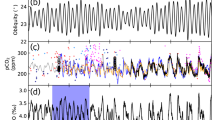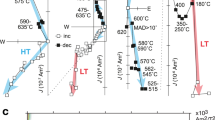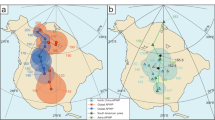Abstract
Milankovitch1 proposed that Earth resides in an interglacial state when its spin axis both tilts to a high obliquity and precesses to align the Northern Hemisphere summer with Earth’s nearest approach to the Sun. This general concept has been elaborated into hypotheses that precession2, obliquity3,4 or combinations of both5,6,7,8 could pace deglaciations during the late Pleistocene9,10. Earlier tests have shown that obliquity paces the late Pleistocene glacial cycles4,11 but have been inconclusive with regard to precession, whose shorter period of about 20,000 years makes phasing more sensitive to timing errors4,11,12. No quantitative test has provided firm evidence for a dual effect. Here I show that both obliquity and precession pace late Pleistocene glacial cycles. Deficiencies in time control that have long stymied efforts to establish orbital effects on deglaciation are overcome using a new statistical test that focuses on maxima in orbital forcing. The results are fully consistent with Milankovitch’s proposal but also admit the possibility that long Southern Hemisphere summers contribute to deglaciation.
This is a preview of subscription content, access via your institution
Access options
Subscribe to this journal
Receive 51 print issues and online access
$199.00 per year
only $3.90 per issue
Buy this article
- Purchase on Springer Link
- Instant access to full article PDF
Prices may be subject to local taxes which are calculated during checkout



Similar content being viewed by others
References
Milankovitch, M. Kanon der Erdbestrahlung und seine Anwendung auf das Eiszeitenproblem 1–503 (Royal Serbian Academy, 1941)
Hays, J., Imbrie, J. & Shackleton, N. Variations in the Earth’s orbit: pacemaker of the ice ages. Science 194, 1121–1132 (1976)
Liu, H. Phase modulation effect of the Rubincam insolation variations. Theor. Appl. Climatol. 61, 217–229 (1998)
Huybers, P. & Wunsch, C. Obliquity pacing of the late Pleistocene glacial terminations. Nature 434, 491–494 (2005)
Imbrie, J. & Imbrie, J. Modeling the climatic response to orbital variations. Science 207, 943–953 (1980)
Paillard, D. The timing of Pleistocene glaciations from a simple multiple-state climate model. Nature 391, 378–381 (1998)
Berger, A., Li, X. & Loutre, M. Modelling northern hemisphere ice volume over the last 3Ma. Quat. Sci. Rev. 18, 1–11 (1999)
Tziperman, E., Raymo, M., Huybers, P. & Wunsch, C. Consequences of pacing the Pleistocene 100 kyr ice ages by nonlinear phase locking to Milankovitch forcing. Paleoceanography 21, PA4206 (2006)
Berger, A. Milankovitch theory and climate. Rev. Geophys. 26, 624–657 (1988)
Saltzman, B. Dynamical Paleoclimatology: Generalized Theory of Global Climate Change (Academic Press, 2002)
Huybers, P. Glacial variability over the last two million years: an extended depth-derived agemodel, continuous obliquity pacing, and the Pleistocene progression. Quat. Sci. Rev. 26, 37–55 (2007)
Kawamura, K. et al. Northern Hemisphere forcing of climatic cycles in Antarctica over the past 360,000 years. Nature 448, 912–916 (2007)
Ghil, M. Cryothermodynamics: the chaotic dynamics of paleoclimate. Physica D 77, 130–159 (1994)
Wunsch, C. The spectral description of climate change including the 100ky energy. Clim. Dyn. 20, 353–363 (2003)
Herschel, J. On the astronomical causes which may influence geological phenomena. Trans. Geol. Soc. Lond. 3, 293–300 (1832)
Huybers, P. Early Pleistocene glacial cycles and the integrated summer insolation forcing. Science 313, 508–511 (2006)
Raymo, M., Lisiecki, L. & Nisancioglu, K. Plio-Pleistocene ice volume, Antarctic climate, and the global δ18O record. Science 313, (2006)
Min, K., Mundil, R., Renne, P. & Ludwig, K. A test for systematic errors in 40Ar/39Ar geochronology through comparison with U/Pb analysis of a 1.1-Ga rhyolite. Geochim. Cosmochim. Acta 64, 73–98 (2000)
Kuiper, K. et al. Synchronizing rock clocks of Earth history. Science 320, 500–504 (2008)
Broecker, W. In Milankovitch and Climate (eds Berger, A. et al.) Part 2, 687–698 (D. Riedel, 1984)
Lisiecki, L. Links between eccentricity forcing and the 100,000-year glacial cycle. Nature Geosci. 3, 349–352 (2010)
Gibbons, J. Nonparametric Methods for Quantitative Analysis 1–487 (American Sciences Press, 1985)
Imbrie, J. et al. On the structure and origin of major glaciation cycles. I: Linear responses to Milankovitch forcing. Paleoceanography 7, 701–738 (1992)
Siddall, M., Chappell, J. & Potter, E. In Developments in Quaternary Science Vol. 7, 75–92 (Elsevier, 2007)
Roe, G. & Allen, M. A comparison of competing explanations for the 100,000-yr ice age cycle. Geophys. Res. Lett. 26, 2259–2262 (1999)
Broecker, W. & Henderson, G. The sequence of events surrounding Termination II and their implications for the cause of glacial-interglacial CO2 changes. Paleoceanography 13, 352–364 (1998)
Schulz, K. & Zeebe, R. Pleistocene glacial terminations triggered by synchronous changes in Southern and Northern Hemisphere insolation: the insolation canon hypothesis. Earth Planet. Sci. Lett. 249, 326–336 (2006)
Huybers, P. & Denton, G. Antarctic temperature at orbital time scales controlled by local summer duration. Nature Geosci. 1, 787–792 (2008)
Timmermann, A., Timm, O., Stott, L. & Menviel, L. The roles of CO2 and orbital forcing in driving Southern Hemispheric temperature variations during the last 21,000 years. J. Clim. 22, 1626–1640 (2009)
Joussaume, S. & Braconnot, P. Sensitivity of paleoclimate simulation results to season definitions. J. Geophys. Res. 102, 1943–1956 (1997)
Acknowledgements
This work benefited from comments by G. Gebbie, L. Lisiecki, A. Stine and C. Wunsch.
Author information
Authors and Affiliations
Ethics declarations
Competing interests
The author declares no competing financial interests.
Supplementary information
Supplementary Information
This zipped file contains the individual Matlab files that were used to generate the statistical and modeling results presented in the main paper. Also included is a supporting file (run_first.m) that contains the search path and three supporting directories that contain a total of 22 other files. Each m-file contains header information that explains its functionality in more detail. (ZIP 20125 kb)
Rights and permissions
About this article
Cite this article
Huybers, P. Combined obliquity and precession pacing of late Pleistocene deglaciations. Nature 480, 229–232 (2011). https://doi.org/10.1038/nature10626
Received:
Accepted:
Issue Date:
DOI: https://doi.org/10.1038/nature10626
This article is cited by
-
Exponential feedback effects in a parametric resonance climate model
Scientific Reports (2023)
-
Middle Pleistocene re-organization of Australian Monsoon
Nature Communications (2023)
-
Seasonal temperatures in West Antarctica during the Holocene
Nature (2023)
-
Late Pleistocene 100-kyr glacial cycles paced by precession forcing of summer insolation
Nature Geoscience (2023)
-
The Mid-Pleistocene Transition: a delayed response to an increasing positive feedback?
Climate Dynamics (2023)
Comments
By submitting a comment you agree to abide by our Terms and Community Guidelines. If you find something abusive or that does not comply with our terms or guidelines please flag it as inappropriate.



